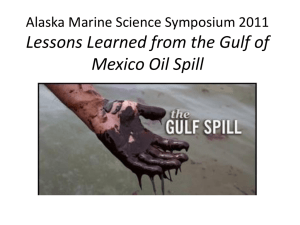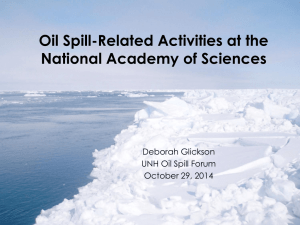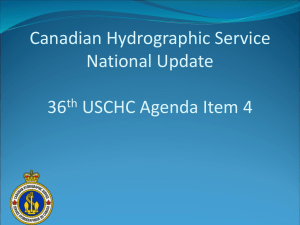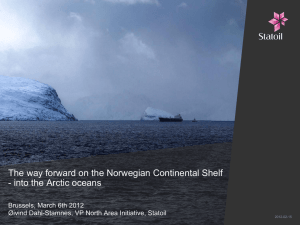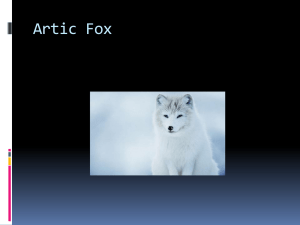National Research Council Report on Arctic Drilling Spill Response
advertisement
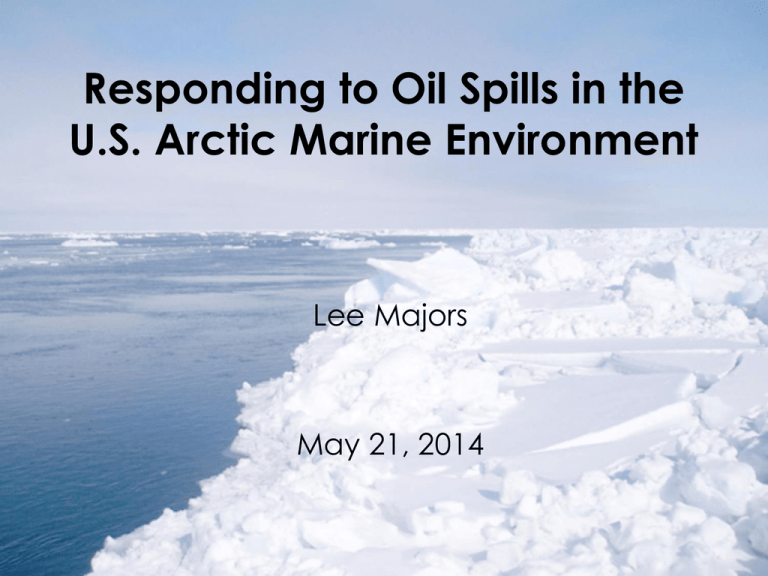
Responding to Oil Spills in the U.S. Arctic Marine Environment Lee Majors May 21, 2014 Setting the Stage • Extreme weather • Vast distances • Lack of infrastructure • Vulnerable Arctic species, ecosystems, cultures • > 2000 miles of shoreline Setting the Stage • Climate change increasing Arctic accessibility for commercial activities • • • • Oil and gas Shipping Fishing? Tourism • Arctic oil spills threaten not only U.S. interests, but all Arctic nations Image sources: NOAA, BOEM National Research Council • Non-government, non-profit • Mission to advise the government • Objective, independent Sponsors • • • • • • • • American Petroleum Institute Arctic Research Commission Bureau of Ocean Energy Management Bureau of Safety and Environmental Enforcement Marine Mammal Commission National Oceanic and Atmospheric Administration Oil Spill Recovery Institute U.S. Coast Guard Summary Statement of Task • Evaluate the current state of science and engineering regarding oil spill response and environmental assessment in Arctic waters • Scenarios – Identify areas where current or potential activities could lead to a marine oil spill • Preparedness – Describe anticipated operating conditions – Assess infrastructure – Identify ways to work with native communities and regional government – Identify gaps for international cooperation Summary Statement of Task (cont’d) • Response and Clean Up – Evaluate effectiveness of current and new response technologies for detection, tracking, separation, and recovery – Identify capabilities/constraints to minimize impacts and enhance wildlife recovery • Environmental Baselines – Characterize types of baseline information needed – Identify sampling and monitoring priorities Committee Roster • Martha Grabowski, Chair - Le Moyne College/Rensselaer Polytechnic Institute • Tom Coolbaugh - ExxonMobil Research and Engineering • David Dickins - DF Dickins Associates, LLC • Richard Glenn - Arctic Slope Regional Corporation • Ken Lee – CSIRO, Australia • Lee Majors - Alaska Clean Seas • Mark Myers - University of Alaska, Fairbanks • Brenda Norcross - University of Alaska, Fairbanks • Mark Reed – SINTEF, Norway • Robert Suydam - North Slope Borough • Jim Tiedje (NAS) - Michigan State University • Mary-Louise Timmermans - Yale University • Peter Wadhams - Cambridge University, UK Outline • Environmental Information Needs • Oil Spill Response Research • Logistics, Operations, Coordination • Strategies for Response and Mitigation Image sources: NOAA, BOEM Scenarios • Shipping • 1 - Passenger vessel • 2 - Oil tanker • 3 - Bulk carrier • 4 – Tug/barge • 5 – Pipeline break • 6 – Wellhead blowout • 7 - Land-based oil tank Image sources: NOAA, BOEM Benchmark Data • Needed to evaluate change over time • In Arctic, few reliable baselines (static) or benchmarks • Critical benchmark data for Arctic oil spill response: – Distribution and abundance: fish, birds, marine mammals – Subsistence/cultural use of living marine resources – Identification and monitoring of areas of biological significance – Rates of change for key species – Sensitivity of key Arctic species to hydrocarbons – High-resolution coastal topography and shelf bathymetry – Ice cover, thickness, distribution Image source: NOAA Long-term Monitoring Needs • What’s needed? – Integration of Arctic data in support of oil spill preparedness, response, and restoration and rehabilitation – International standards for Arctic data collection, sharing, and integration – A long-term, community-based, multiuse Arctic observing system – Release of proprietary monitoring data from oil and gas exploration activities – When appropriate, release of native community fishing, hunting, and cultural site data Image sources: NOAA, UAF Recommendations • A real-time Arctic ocean-ice-meteorological forecasting system is needed…and must be supported by robust, sustainable, and effective acquisition of relevant observational data. – Ice movement, type – Sea state, storm surge – Ocean stratification and circulation • Arctic nautical charting and shoreline mapping in NOAA and USGS plans should be adequately resourced…initiated, continued, and completed in timescales relevant to anticipated changes. – Priorities should be developed in consultation with stakeholders and industry The Oil Spill Toolbox • No single technique will apply in all situations. • Effective oil spill response requires flexibility to evaluate and apply multiple response options, whether on their own or concurrently. • Timing, capacity, local conditions Image source: USCG Oil Spill Response Research • There has already been much work on behavior of oil in temperate and cold environments • Needed: a comprehensive, collaborative, long-term Arctic oil spill research and development program that integrates – Oil behavior—oil & sea ice formation, transport, fate – Oil spill response and countermeasures • Detection, monitoring, modeling • Biodegradation and dispersants • In situ burning • Mechanical containment • Natural recovery – Improved data & forecasting models Oil Spill Countermeasures • Specific R&D needs: Improved ignition methods for in situ burning Dispersant effectiveness at low temperatures Understanding limits of mechanical recovery Improved under-ice detection and response Integrating remote sensing and observational techniques for detection and tracking – Determining/verifying hydrocarbon biodegradation rates – Evaluating the toxicity of dispersants and chemically dispersed oil on key Arctic marine species – – – – – Recommendations • A systematic program of carefully planned and controlled field experiments that release oil in the U.S. Arctic is needed to advance understanding of oil behavior and response options. • Dispersant pre-approval in Alaska should be based on sound science: – Research on fates and effects of chemically-dispersed oil in the environment – Experiments using Arctic-like oils – Toxicity tests of chemically-dispersed oil at realistic concentrations and exposures – Use of representative Arctic species at appropriate conditions Coast Guard Needs • Low level of presence in Arctic, especially in winter • Needed: – – – – area-specific training icebreakers vessels aircraft and helicopter support facilities • Arctic assignments for trained and experienced personnel and tribal liaisons should be of longer duration • Sustained funding will be needed to increase the USCG presence in the Arctic and to strengthen and expand their ongoing Arctic oil spill research programs Image source: USCG Vessel Traffic • Not actively managed or monitored in the Bering Strait or in the U.S. Arctic • No comprehensive system for real-time traffic monitoring • Significant vulnerability for U.S. Arctic missions, including oil spill response • The Coast Guard should expedite Bering Strait traffic evaluation – is monitoring warranted? Image source Alaska Marine Exchange Arctic Infrastructure • Lack of infrastructure is a significant liability • Effective oil spill response requires improved: – Communications, transportation, traffic monitoring systems – Stronger supply chains, pre-deployed response equipment – Improved port and air access – Personnel, berthing, housing, waste and medical support facilities – Human & organizational infrastructure—tribal liaisons, training – Integrated scientific and traditional knowledge • No funding mechanism for development, deployment, and maintenance of temporary and permanent infrastructure • A public-private-municipal partnership that receives a percentage of revenues and royalties could help develop infrastructure Image source: NOAA Community Engagement • Community expertise - Local knowledge is key before and during a response • Local response - Develop and maintain trained village response teams – USCG – ADEC Image sources: NOAA, USCG International Agreements • Formal contingency planning and exercises with Canada • Russia’s expansion of vessel traffic through the Bering Strait • Resolving anticipated response problems with Russia (e.g., communications, translators, people and equipment) needs to be done before an event, through an active exercise program • Build on existing bilateral agreements with Russia and Canada to develop and exercise a joint contingency plan Wildlife Impacts • Federal and state agencies, comanagement organizations, and local government and communities should work together with industry to improve deterrent and rehabilitation methods • Universities, NGOs, and others could help with R&D to improve methods Image source: NOAA Net Environmental Benefit Analysis (NEBA)Processes • Identify effective countermeasures, analyze environmental tradeoffs – – – – – Protect sensitive/important ecosystem components Include information on oil transport, fate, and effects Knowledge of operational limits Weigh pros and cons of each countermeasure Consider logistical constraints and cleanup intensity • Response options with least adverse environmental impacts – Impacts on Arctic food webs, dynamics at different trophic levels • Process should involve regulators, resource managers, health authorities, technical specialists, scientific experts, and local experts. Summary • Environmental Information Needs – Benchmark data, observing, monitoring, charting/mapping • Oil Spill Response Research – Comprehensive, collaborative R&D, controlled oil release, flexibility in toolbox, R&D needs • Logistics, Operations, Coordination – Infrastructure, Coast Guard needs, vessel traffic, local and int’l needs • Strategies for Response and Mitigation – Decisions processes, wildlife mitigation/rehab Thank you. The report can be downloaded here: Oil interacts with the environment in complex ways Oil and Gas Activity
